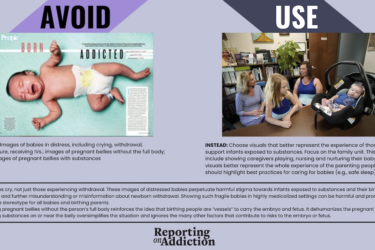 During the making of “Hiding in Plain Sight: Documenting the crisis in kids’ mental health,” a then-executive at the National Institute of Mental Health advised the filmmakers to insert the term “lived experience” in every place that “mental illness” otherwise might have been. A Johns Hopkins University psychologist suggested “mental health condition” as the optimal reference.
During the making of “Hiding in Plain Sight: Documenting the crisis in kids’ mental health,” a then-executive at the National Institute of Mental Health advised the filmmakers to insert the term “lived experience” in every place that “mental illness” otherwise might have been. A Johns Hopkins University psychologist suggested “mental health condition” as the optimal reference.
“Addict” is what Makalynn Powell, one of the 20 children, teens and young adults spotlighted in “Hiding in Plain Sight,” called her father. His disorder, incarceration and absences from her life drive the mental trauma the 24-year-old details in “Hiding,” a PBS documentary.
On Wednesday, May 25, at 3 p.m. CST, AHCJ is hosting a webinar about this film that will feature Powell; Collin Cord, a high schooler also spotlighted in this documentary by brothers Erik Ewers and Christopher Ewers; the filmmakers; and several sneak-peek clips from the documentary. The film will air on June 27 and 28 and will be presented by celebrity documentary-maker Ken Burns, with whom the award-winning Ewers brothers have worked.
Letting the people they spotlighted — the youngest of them was 11— use their own preferred words to detail how they and their peers grapple with mental health seemed like the best approach, the Ewers told AHCJ.
“The whole film is like a big group therapy session. That’s why we had all our interviewees look straight at the viewer,” Erik said.
The documentary comes as clinicians cite a record surge in diagnosed mental illness among children, adolescents and young adults. It’s couched in light of a pandemic, Black Lives Matter, MeToo and other social upheavals that Cord, understatedly but empathetically, describes as “unpleasant” in the film.
The webinar will explore, among other topics:
- Why the Ewers chose this topic. (The next installment of “Hiding in Place” will tackle mental illness among adults, they said.)
- How the filmmakers selected the people they spotlighted and how they got them to open up candidly and deeply.
- How the filmmakers decided which questions to ask.
- How the film tackles and aims to lessen stigma.
- What the four panelists believe journalists should be covering regarding youth/young adult mental illness including what’s missing from existing coverage and where coverage has excelled or fallen short.
- What outside experts, parents, teachers, friends and health care providers have to say about the plight of kids with mental health disorders and their resilience.
- Why the filmmakers opted against using prescribed language (“lived experience,” “mental health conditions” et al.) that some journalists and others, consider too euphemistic and imprecise to best illustrate news stories.
Resources for reporters
- This 2021 American Academy of Pediatrics, American Academy of Child and Adolescent Psychiatry and Children’s Hospital Association declaration of a “national emergency” in child and adolescent mental health.
- “Ring the Alarm,” a 2019 Congressional Black Caucus-commissioned report on the rise in suicides among Black youth.
- This 2021 Trevor Project nationwide survey of LGBTQ youth’s mental health and this 2022 Trevor Project report on mental health among Asian American LGBTQ youth.
- This 2021 Journal of Young Investigators analysis of anxiety among Asian American Youth.
- “American Rescue Plan Helps States Respond to Youth Mental Health Crisis,” a 2022 Georgetown University Center for Children and Families white paper.
- “How a lack of rural mental health professionals affects youth,” a 2020 commentary published by Policylab at Children’s Hospital of Philadelphia.
- This 2021 Native Center for Behavioral Health video on “Native Youth Mental Health and Suicide Awareness.”
- This 2021 National Research Center on Hispanic Children & Families analysis of several reports on depression, hopelessness, etc. among those youth.







